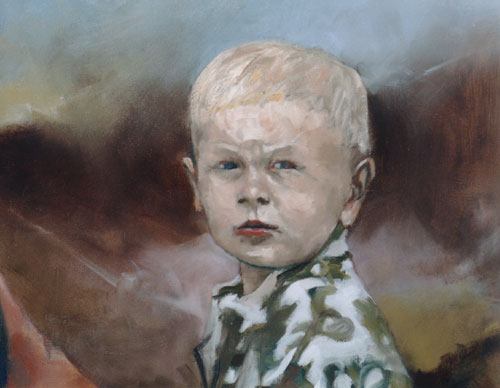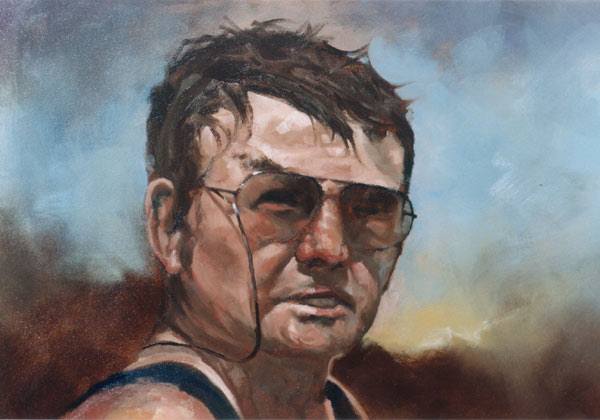|
John Morgan and his wife Robyn own and operate a large earthmoving and road-making company. John has always been a 'hands on' manager and is often happiest working alongside his men and is attired accordingly. His grandson Sam takes after his Grandfather, whom he follows around whenever he can. He tries to do all those things his grandfather does and is a born mimic in this regard. So much so John bought Sam a battery and gear operated little four-wheeled vehicle of his own. The three-year-old Sam is remarkable in his ability to maneuver his little vehicle 'just like his grandfather'. Needless to say a firm bond exists between the two.
After assembling all my sketches, color notes and photographs of the subjects I set about thinking of how exactly I was going to fit both into the one painting. I finally decided on an arrangement that would combine them by their similar facial expressions that leave no doubt as to their closeness. They are posed to look out of the picture as if challenging the world to view them in their space as they would view the world.

You will note the huge difference in skin-tone between the weather-beaten and tanned John, and the milky fairness of Sam. His skin is very pale, his eyes blue and hair fair. Nevertheless I used the same palette for both.
I began the painting with an imprimatura of raw umber which I allowed to dry. I then drew in my figures using charcoal. Next I worked the deepest shadows with a thin mix of raw umber and cobalt blue with a little light red where I wanted a little temperature variation.
Working up with a slightly thicker mixture I started blocking-in the semi-tones. This is the stage that should take the longest and the painter taking great care to get all the values correct. Keep working them towards the light by adding a higher value color as well as introducing as many interesting tonal variations you can.
Now I can work and blend my shadow planes with a thicker mix of light red, naples yellow and raw sienna being careful not to bring the highlights up too soon. As I am doing all this I will usually wipe excess paint from my brush on the canvas around the figures.
When I am satisfied with my shapes and planes I will begin to detail some of the features, mouth, eyes, nose and hair with a small brush and a 'long' easy flowing mixture of paint.
Now I will add the highlights to the face glasses and hair. John lost an eye in his 20's therefore the slight difference in the eyes.
 Finally I add the simplest of all backgrounds, an atmospheric mix of light and darks composed entirely of all the colors I have already used. This also generally cleans up my palette nicely.
Finally I add the simplest of all backgrounds, an atmospheric mix of light and darks composed entirely of all the colors I have already used. This also generally cleans up my palette nicely.
STUDENT ACTIVITY: Print out a copy of the painting and nominate all the shifts in value by placing a number from 1 to 10 on the specific areas. Refer back to the lesson on colors if you are in doubt as to what is meant by color 'values'.
|